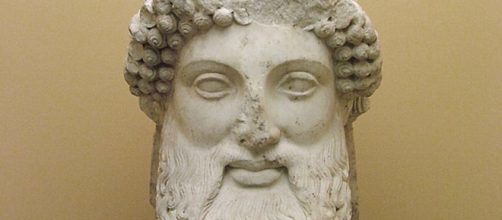The news out of Athens on Sunday November 15 sounded like a Grimms’ Fairytale of haunted mansions and bloody pickaxes. The Los Angeles Times reported a male head found by workmen fixing a sewer in the middle of the city.
Hermes, is that you?
But wait, this was a tale of history, not horror. The head isn’t human. It’s an ancient relic from 300 B.C. The Greek Culture Ministry identified the face as the mythological god Hermes once used as a street marker.
Inglorious end
The Ministry also said that while most renditions of Hermes show him as a youth, the one found in the sewer is that of an older man and likely carved by the celebrated Greek sculptor Alcamenes.
So, how did a sculpture of a Greek god by a famed artist end up in a sewer? The Ministry supposes that the head had been set in a drainage duct wall.
Behind the scenes
Despite the facts of ancient history, finding a head in a sewer sets the imagination in motion. I’m thinking of the Swiss psychiatrist Carl Jung’s describing Hermes as an emissary between two worlds – earthly and divine - and a guide to the underworld.
Movie madness
Anthony Stevens's 1990 book “On Jung” keeps the imagination going by tying Jung’s views on psychology to his experiences. This is what I’m doing now, relating the bodiless head to my experiences watching spooky movies like “The Thing That Couldn’t Die” (1958). I keep thinking, the find in Athens may be the thing that couldn’t die.
Top this
Then there’s the historical fact that the ancient Greeks credited Hermes for his magical powers and Jung saw him as a trickster. Hold that thought because in the same week that Hermes' head showed up in an Athens sewer, Egyptian archaeologists made an unusual discovery: more than 100 painted coffins unearthed near Cairo dating back to 600 B.C.
After serving as a street marker back in ancient Athens, the head, at some point, had been built into the wall of a drainage duct. https://t.co/reO56PH3UP
— USA TODAY (@USATODAY) November 16, 2020Mysterious discovery
The Art Newspaper quoted Mostafa Waziri, Secretary-General of Egypt’s Supreme Council of Antiquities saying that finding so many Old Nile coffins is “the biggest discovery in 2020.”
Egyptian archaeologists opened one of the coffins and X-rayed the mummy within to find a male with arms crossed over his chest the way the Egyptian god Osiris was known to do.
The mysterious detail was that all of the mummy’s internal organs were missing, except for the heart, reports the Art Newspaper.
More to come
Just a month before, archaeologists unearthed 59 other coffins. El-Enany, Egypt’s minister of tourism and antiquities, said: “We still have a lot to reveal,” reports the Art Newspaper.


